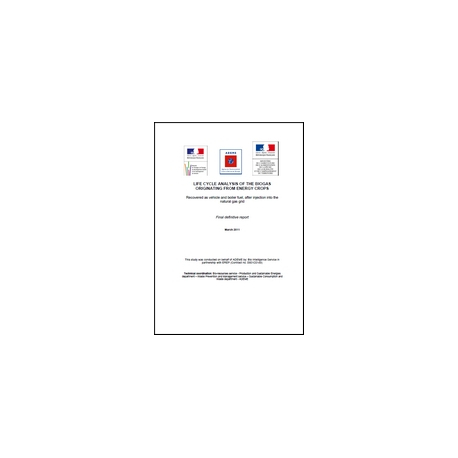 Agrandir l'image
Agrandir l'image
Life cycle analysis of the biogas originating from energy crops
Recovered as vehicle and boiler fuel, after injection into the natural gas grid
Neuf
This LCA study was conducted by BioIS-Erep within 2010-2011 on behalf of ADEME. It assesses the impacts of the production of biogas from agricultural use of energy crops in co-digestion with manure type substrates. It examines in particular the use of different crops (maize, sorghum, grasslands, grass strips) with scenarios[…] Plus de détails
Télécharger les fichiers
- _80943__ADEME_BIO_ACV_biomethane_synthese_EN.pdf — 1.01MB
- _80943__ACV_biomethane_rapport_final_v3_0_EN.pdf — 4.80MB
- _80943__Annexes_v3_0_EN.pdf — 738.15kB
Fiche technique
| Auteurs | BIO INTELLIGENCE SERVICE, EREP, ADEME |
| Public(s) | Secteur de la recherche |
| Thématique | Energies renouvelables, réseaux et stockage |
| Produire autrement | |
| Collection | Hors collection |
| Date d'édition | 2011/03 |
| Nb. de pages | 29 P + 122 P |
| Format | pdf/A4 |
| Langue | EN |
| Périmètre de publication | National |
En savoir plus
This LCA study was conducted by BioIS-Erep within 2010-2011 on behalf of ADEME. It assesses the impacts of the production of biogas from agricultural use of energy crops in co-digestion with manure type substrates. It examines in particular the use of different crops (maize, sorghum, grasslands, grass strips) with scenarios varying from biogas from energy crops (from 1 / 3 to 90%). Two uses of biogas produced (fuel vehicle and boiler, after injection into the natural gas grid) were studied by comparing each time the impacts of biomethane to those of fossil fuels (natural gas, diesel).
The main conclusions of this study are:
- these pathways would enable to reduce from 50% to 70% GHG emissions compared to fossil fuels. These estimated results do not take into account land use changes and associated effects. These last ones can reduce the final balance;
- these pathways would allows gains on the consumption of nonrenewable energy by MJ of product, but they are lower than those for GHG emissions;
- the incorporation of energy crops results in overall adverse developments with respect to other sectors of fossil impact categories: acidification, eutrophication potential or water consumption.
A French version is available.



